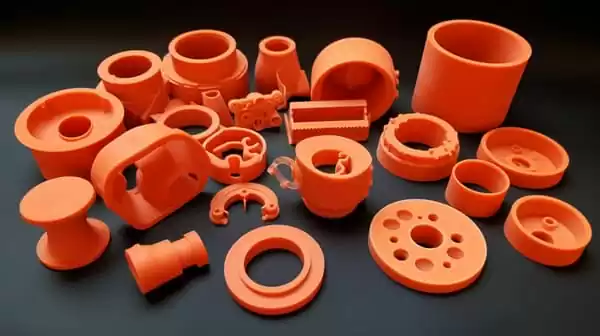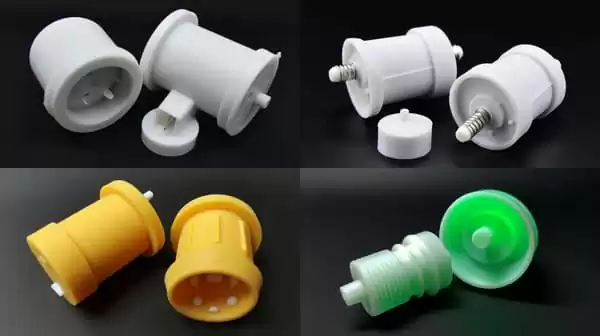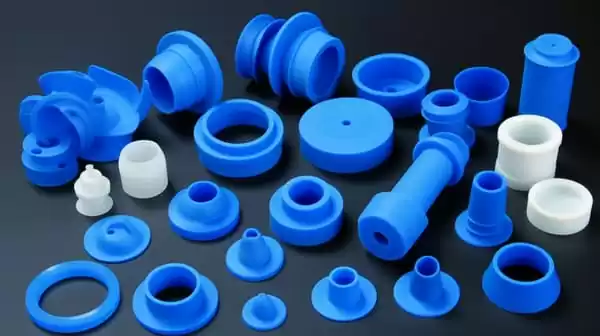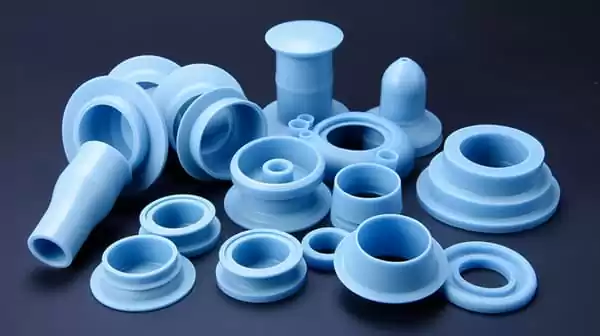Introduction
Silicone rubber is an elastomer made from silicone materials processed into a rubber-like form. It has become widely used due to its superior thermal stability, electrical insulation, and chemical resistance properties. Silicone rubber finds applications from household items to high-tech engineering components.
Silicone rubber’s impact on various industries cannot be overemphasized. In the automotive sector, silicone rubber is commonly used for engine seals, gaskets, and hoses due to its resistance to high temperatures and chemical corrosion. Silicone rubber is widely used in the aerospace industry for fuel seals, wire and cable insulation, as well as airframe components. Medical device manufacturers also utilize silicone rubber for implantable or disposable devices due to its biocompatibility and flexibility. Silicone rubber is widely used in the electrical industry as an insulating material and protective coating due to its electrical insulation properties. Additionally, it’s found in household items like baking molds and kitchen utensils due to its non-stick and heat-resistant qualities.

Overall, silicone rubber is an incredibly versatile material with numerous properties that make it suitable for use across a range of industries. Due to its market importance and practicality, research and development activities are ongoing in this area; new materials and technological developments are made regularly.
II. Engineering uses of silicone rubber
Silicone rubber has many engineering uses in industries such as automotive, aerospace, medical devices, and electrical. One of the primary advantages of silicone rubber is its high thermal stability; making it suitable for use in extreme and high temperature, environments.
Here are some examples of engineering applications involving silicone rubber:
Automotive:
Engine seals and gaskets
Hoses
Transmission and brake systems
Electrical connectors and cables
Aerospace:
Fuel seals
Wire and cable insulation
Airframe components
Electrical connectors and cables
Medical Devices:
Implantable devices
Disposable devices
Medical tubing
Surgical instruments
Electrical:
Insulating materials

Protective coatings
High-voltage cable insulation
Circuit board coatings
Silicone rubber has many qualities that make it a desirable material for engineering applications. It boasts excellent resistance to chemicals, UV radiation, heat and aging as well as being highly flexible with excellent tear strength – ideal for applications where repeated flexing and movement take place.
Overall, silicone rubber has many engineering applications and has proven its reliability and efficiency in various scenarios. Its unique properties have made it a necessity in many industries, with ongoing research and development leading to even superior silicone rubber materials and products developed.
III. Advantages of silicone rubber
Silicone rubber offers numerous advantages that make it a highly desirable material for many applications. Here are some of the key advantages of silicone rubber:
Thermal Stability and Resistance to High Temperatures:
Silicone rubber is ideal for applications requiring heat resistance due to its outstanding thermal stability, with temperatures capable of withstanding up to 300degC. As such a temperature well, it makes an ideal material choice in harsh climates.

Physical Properties such as Tensile Strength and Flame Retardancy:
Silicone rubber boasts impressive physical characteristics, better properties such as high tensile strength and elongation. Furthermore, its flame retardancy properties make it a safe material to use in applications requiring fire resistance.
Electrical Properties:
Silicone rubber is an ideal electrical insulator, ideal for use in electrical and electronic applications. With high dielectric strength, low dielectric constant, and low dissipation factor, it makes an ideal material for insulation, coatings, and adhesives.
Durability and long lifespan:
Silicone rubber is an extremely durable material, resistant to exposure to chemicals, UV radiation, and weathering. Furthermore, its resistance to aging makes it perfect for applications where longevity is critical.
Overall, silicone rubber’s unique combination of thermal stability, physical properties, electrical characteristics, durability, and long lifespan make it an attractive material for numerous applications. Thanks to these excellent characteristics, research, and development have been ongoing to produce even superior silicone rubber materials and products.
IV. Why is silicone rubber expensive?
Silicone rubber is an incredibly valuable material, though it comes at a higher cost than many other rubbers or plastics. There are several reasons why silicone rubber is more costly:
Cost factors including manufacturing and processing techniques:
Silicone rubber is an artificial material requiring the fabrication through a complex production process with multiple steps. High-quality raw materials must be used, while expensive equipment makes the cost of production high. Furthermore, this step-by-step procedure requires considerable energy consumption which further contributes to its expense.

Importance of Quality Control and Patented Technologies:
Silicone rubber is often employed in applications requiring high performance and dependability, making quality control an absolute must guarantee the material meets all required specifications. Unfortunately, this manufacturing process necessitates specialized equipment and expertise which adds to the cost of production. Furthermore, many silicone rubber products incorporate patented technologies which further adds to the final product cost.
Silicone rubber, despite its higher cost, is an invaluable material due to its special properties and advantages. It finds applications where high performance, reliability, and safety are critical such as medical devices, automotive components, and aerospace parts. Silicone rubber’s durability and resistance to extreme temperatures and chemicals make it suitable for a wide range of tasks.
Overall, silicone rubber is expensive due to the time and resources invested in the process of producing a superior material with exceptional performance. Companies producing this type of rubber invest heavily in research and development to refine their products and processes, leading to ongoing advances within the silicone industry.
V. Advances in silicone rubber material technology
The the silicone rubbers industry is rapidly advancing, with leading companies developing cutting-edge materials and technologies. These developments have drastically improved the properties of modern silicone rubbers, leading to innovative products and components with superior performance in numerous applications.
Here are some recent examples of advances in silicone rubber material technology:
New Materials and Technologies:
Leading companies in the silicone industry have developed materials and technologies to enhance silicone rubber’s performance. For instance, one company’s patented compo sil technology combines organic compounds with silica for exceptional physical and electrical characteristics. Other firms have created liquid silicone rubber (LSR) materials with superior processing characteristics for complex parts.
Improved Properties:
Leading silicone rubber materials have recently undergone significant improvements, such as increased tensile strength, tear resistance, and flame retardancy. These qualities make them ideal for applications where high performance and reliability are essential requirements.
New Products and Components:
Recent advancements in silicone rubber material technology have allowed manufacturers to create innovative new products and components made of this versatile material. Medical device companies are using LSR materials for implantable devices with superior biocompatibility and long-term performance, while automotive industries use high-performance silicone rubber gaskets and seals that offer excellent resistance against high temperatures as well as chemical corrosion.

Overall, recent advances in silicone rubber material technology have produced considerably improved properties, processing capabilities, and applications. As a result, new and improved products and components offer superior performance, longevity, and dependability across various industries.
VI.Challenges and future developments
Silicone rubber material technology presents many advantages and potential uses, but also challenges and untapped potentials for future advancement. Here are some of the challenges encountered by silicone rubber material technology:
Markets and Demand for Silicone Rubber:
The silicone rubber market is expected to experience steady growth over the coming years due to increased demand from various industries. However, challenges related to raw material availability and costs could limit the supply of silicone rubber.
Importance of Exceeding Customer Expectations:
As silicone rubber continues to be utilized in various applications, there is an urgent need to meet customer demands and expectations. This includes creating materials and products with improved performance characteristics, durability, and safety features.
Research and development activities related to silicone materials and technology include:
Research and development are essential for the future of silicone rubber. Companies are investing in R&D to develop new materials and technologies that enhance their properties and performance. For instance, for example, some are investigating innovative techniques for processing and fabricating silicone rubber such as 3D printing or injection molding.
Challenges related to thickness and surface quality:
Silicone rubber presents several obstacles when it comes to attaining the desired thickness and surface finish quality, particularly for applications such as medical devices or aerospace components where precision and dependability are essential factors.
Overall, the the silicone rubber mold industry faces both challenges and opportunities for its future development. Meeting consumer demands silicone rubber while developing new materials and technologies that enhance its properties and performance will be key factors in ensuring its continued success.

Conclusion
In conclusion, silicone rubber is an incredibly versatile material with numerous advantages that make it suitable for various industries such as automotive, aerospace, medical devices, and electrical. Its special properties like thermal stability, physical characteristics, electrical properties durability, and long lifespan make it an attractive material choice across a variety of applications.
The rapid advancements in silicone rubber material technology have produced new materials and processes that significantly enhance its properties, leading to innovative products and components. Furthermore, there remains enormous potential for further advancements within this industry as research and development continue to propel it forward.
Overall, the silicone industry is essential in providing high-performance materials for various applications and its significance is expected to increase over time. With an increasing demand for silicone rubber, companies will continue investing in research and development – leading to further advancements in the silicone rubber sheets, materials and new technology used.



